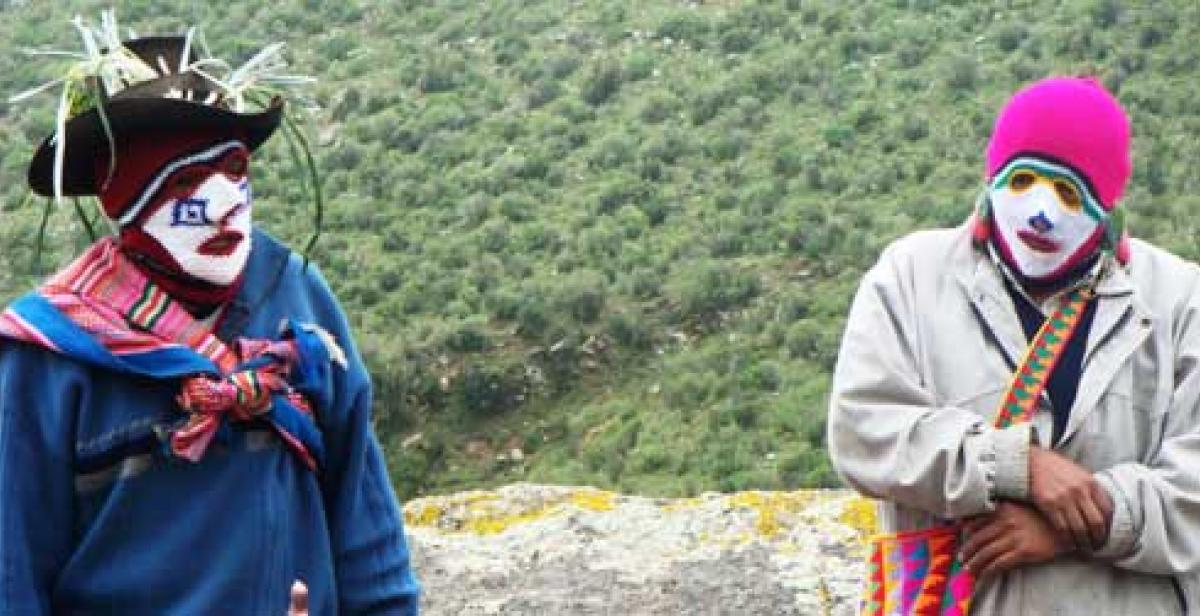It’s 4:30 am and I wake to the sound of the donkey’s bray. I’m in the village of Tupicocha in the Peruvian Andes, at an altitude of 3500m.
Today, the villagers of Tupicocha gather for the annual Water Harvesting Feast – a celebration to inaugurate the water harvesting practice known by the locals as ‘Amunas’.
Water harvesting techniques were once widespread in the Andean highlands, together with other pre-Hispanic techniques to store, capture, conduct and distribute water. Nowadays most of these practices go unnoticed or have even disappeared. So my fellow development worker Diego and I are really excited at the idea that within a few hours we too will be taking part in the celebration.
It’s a tough 4-hour climb to the ceremonial place at 4500m high. The president of the community designates four participants who will embody the protectors of the water: the local deities Tayta Pingollo (Water, represented by a skull) and Mama Capiana (Mother Earth).
After the four ‘Huares’ have been named, they retire from the ceremonial place to transform themselves into the protectors of the waters. Then, following the course of the canal, they return to the ceremonial place to the sound of the tinya (small drum) and wakrapuco (bull horn trumpet). They each hold one corner of the ritual cloth on which they carry the offerings and the skull of Tayta Pingollo.
The transformation is impressive. The villagers here are usually quiet and discreet people. So it is a real surprise to see the ‘Huares’ in bright disguises, speaking forcefully in falsetto voices, and using a unique sense of humour to personify the deities.
It is hilarious to see the ‘Huares’ tease the others present, as they assess what has or has not been done this year to protect the water resources, and symbolically punish the individuals who have misbehaved using a whip.
What at first glance seems like a very cheerful event turns out to have a deeper significance and proves to be an ingenious and locally-accepted way to raise concerns without generating conflicts.
The next part of the ritual consists of honouring the protectors of the water through offerings of coca leaves, alcohol and tobacco. The participants dance and shout, shovels in hand, warming up before the hard work can start.
Just as I am starting to freeze, we are invited to join the dance, celebrating the water and the collective work that is to follow. It is beautiful to see how this celebration unifies the villagers of Tupicocha, and increases their sense of responsibility as well as their motivation to protect and manage the water resources.
After the celebration the community members pick up their shovels and head towards the ‘Acequias Amuneras’, special canals made of rocks and soil, to clean and restore them. They use these canals to redirect water from the river during the rainy season to specific places in the mountain where the structure of the rocks and the soil allow a natural absorption of the water to recharge the aquifers.
This water travels downwards very slowly to appear six months later, during the dry season, where it feeds the springs or ‘puquios’ (underground water ducts) hundreds of metres below, giving the local population access to water for agricultural and domestic purposes.
The water recharge also helps to reduce erosion of the slopes and contributes to the conservation of the existing vegetation.
This water harvesting system dates from pre-Hispanic times and it is striking to see how, thanks to the collective efforts of the community members, who spend hours shovelling stones and soil, the canals can still be used today.
After the ceremony, while the community members are at work cleaning the canals, we start a long but beautiful walk back through the mountains of Tupicocha. During the walk, so many questions come to my mind: How long did it take the ancestors of the Tupicochans to experiment and get to know their territory well enough to manage their water resources in such an effective way? How was this tradition maintained by the Tupicochans within a constantly evolving context?
One thing is for sure, Andean communities have always been faced with tremendous climatic extremes. On top of this Peru is one of the most vulnerable countries when it comes to climate change, especially the rural population who are experiencing more droughts, floods, hailstorms and other unpredictable weather events than ever.
However, over the years, the people’s understanding of the water cycle and the mountains – as reflected in the water harvesting practice of the Tupicochans – has proven effective in reducing the vulnerability of Andean communities to climatic extremes on the long term. It is therefore a shame that many national and international initiatives seeking to promote adaptation to climate change do not take these ancestral practices into account.
Understanding the Andean social management of natural resources helps us realise that the process of adaptation to climate change and prevention of water scarcity will not just depend on the construction of sophisticated infrastructures and transfer of specialised knowledge. It also entails a long term relationship with the natural environment in a social and cultural context that gives meaning to the protection of these natural resources.
Fortunately the Tupicochans are aware of the importance of their tradition and are proud to share it with the few outsiders that show an interest. Thanks to our work with our partner organisations we are able to learn more about ancestral natural resource management systems and promote these sustainable and effective ways of adapting to climate change – ways that could be replicated and adapted to other localities of Peru and the world.
Cindy Krose and her fellow Progressio development worker Diego Arevalo, together with partner organisations GEA and CEPES, work on projects that seek to reduce the vulnerabilities of Andean communities in the context of increasing climatic extremes.



